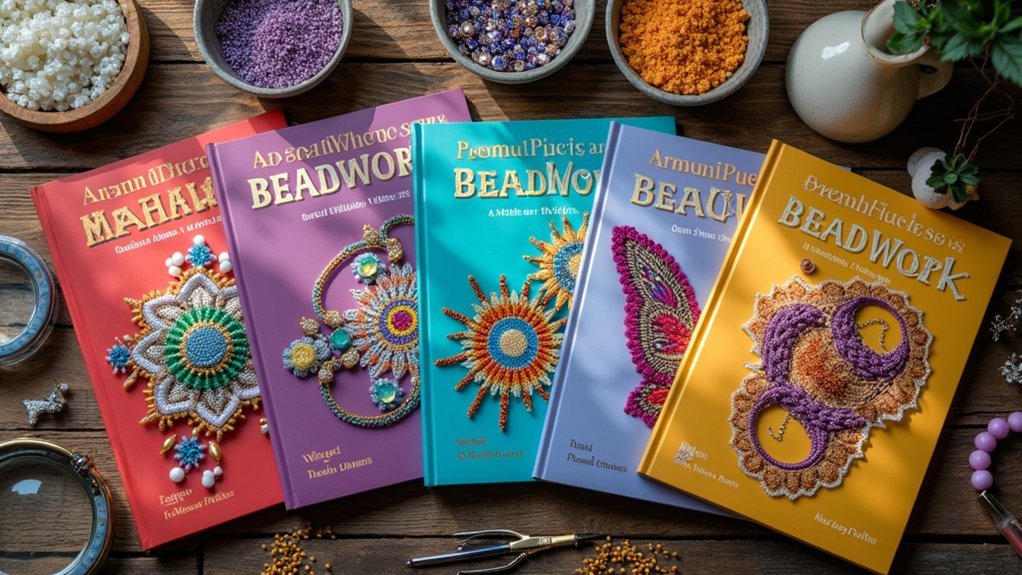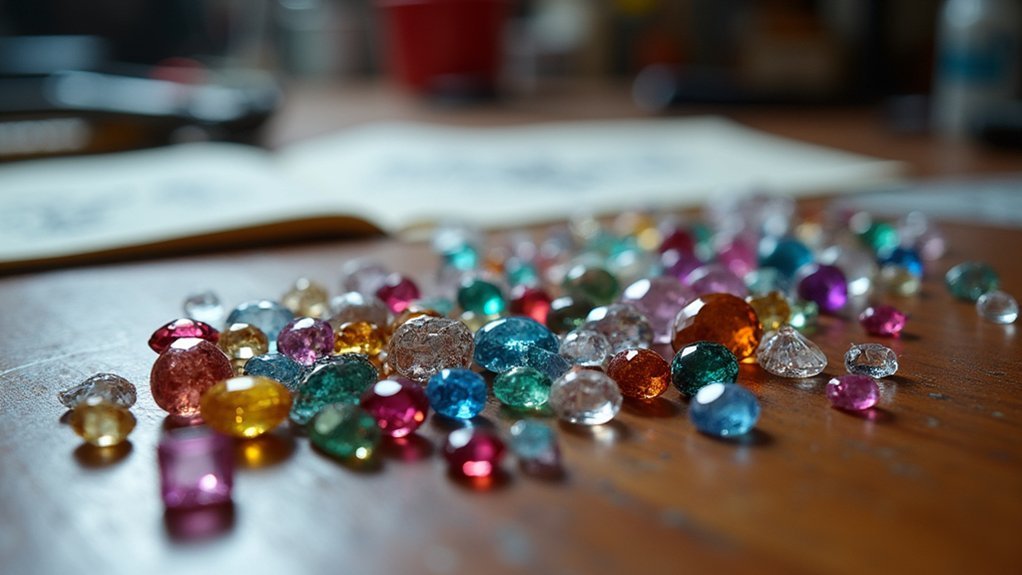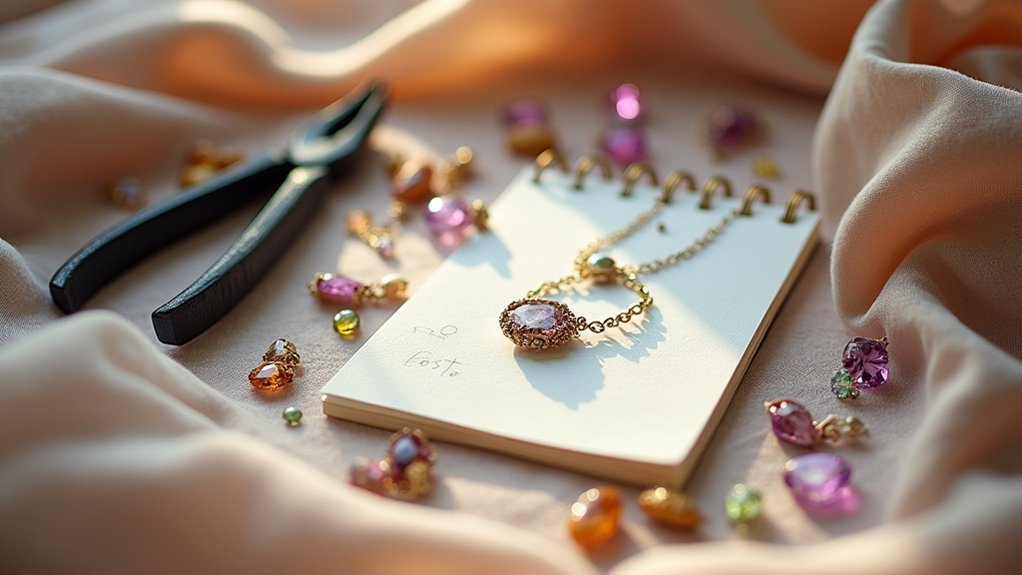Are you ready to elevate your beadwork in 2025? You’ll need fresh inspiration to take your crafting to the next level, and the right pattern book can make all the difference. From intricate seed bead designs to traditional Native American techniques, this year’s standout guides offer something for every skill level. Whether you’re a beginner looking to master the basics or an experienced beader seeking complex challenges, these five exceptional resources will transform your creative journey.
Bead Weaving on a Loom: Techniques for Making Beautiful Jewelry
If you’re a beginner looking to enter the world of bead weaving, this concise 26-page guide provides clear, straightforward instructions that won’t overwhelm you with complexity. The book focuses primarily on the Clover loom, covering essential materials, two warping methods, and increasing/decreasing techniques.
While some readers find the projects simplistic, the well-illustrated instructions make your first loom projects achievable. You’ll find 11 projects to practice with, though you might wish for more finishing technique details. Despite its limitations and thin content, it serves as a solid starting point before you tackle more complex designs.
Best For: Absolute beginners to bead weaving who own or plan to purchase a Clover loom and prefer simple, straightforward instructions with basic projects to build foundational skills.
Pros:
- Clear, well-illustrated instructions that make first bead loom projects accessible and achievable for novices
- Concise format that doesn’t overwhelm beginners with excessive complexity or information
- Includes essential techniques like warping methods and increasing/decreasing patterns to build fundamental skills
Cons:
- Very limited content at only 26 pages, which many readers feel doesn’t justify the price
- Focuses almost exclusively on Clover looms, limiting usefulness for those with different loom types
- Lacks comprehensive finishing techniques and contains relatively simplistic projects that advanced crafters might find too basic
Marcia Decoder’s Beaded Opulence: Elegant Jewelry Projects
Marcia Decoder’s “Beaded Opulence” stands as a treasure trove for beadweavers seeking to master Right Angle Weave techniques through elegant jewelry designs. This hardback volume contains 24 projects spanning beginner to advanced skill levels, organized across eight detailed chapters.
You’ll appreciate the clear instructions, excellent diagrams, and stunning photography that make each project accessible. The book methodically builds your skills from flat beading to complex layered designs. With specific bead colors listed for each project, you can precisely replicate her elegant pieces or draw inspiration for your own creations. The included gallery of other artists’ work provides additional creative fuel for your beadweaving journey.
Best For: Intermediate to advanced beaders looking to master Right Angle Weave techniques and create elegant jewelry with detailed guidance and inspiration.
Pros:
- Features 24 diverse projects ranging from beginner to advanced levels with crystal-clear instructions and excellent diagrams
- Hardback format offers durability during beading sessions and provides comprehensive coverage of Right Angle Weave techniques
- Includes specific bead colors for precise replication and a gallery of other artists’ work for additional inspiration
Cons:
- Some projects may be too intricate for absolute beginners despite being labeled as suitable for various skill levels
- Certain materials mentioned in projects may be difficult to find or source
- Contains some older designs alongside new ones, which might disappoint those looking exclusively for fresh content
Seed Bead Chic: 25 Elegant Jewelry Projects
Intermediate beaders looking for elegant projects inspired by fine jewelry will find Amy Katz’s “Seed Bead Chic” a valuable addition to their crafting library. The book presents 25 classy designs that showcase Katz’s talent for creating professional-looking pieces using primarily seed beads.
You’ll appreciate the clear diagrams and instructions that combine verbal and visual guidance. While some advanced beaders might find certain projects less challenging, the diversity of techniques and creative mix-and-match potential make this book worthwhile. It’s particularly useful for utilizing your round seed bead collection through designs that transform basic materials into sophisticated jewelry.
Best For: Intermediate beaders seeking elegant, fine jewelry-inspired designs that maximize their seed bead collections while developing their skills through diverse techniques.
Pros:
- Clear instructions with helpful diagrams and visual aids make projects accessible
- Offers 25 elegant, professional-looking designs that can be mixed and matched
- Excellent for utilizing round seed bead collections with sophisticated results
Cons:
- May not offer sufficient challenge for advanced beaders
- Some designs might be too complex for complete beginners
- Limited to primarily seed bead techniques rather than incorporating diverse materials
Beadwork Techniques of the Native Americans
Native American beadwork stands as a timeless art form that’s perfect for crafters seeking to connect with Indigenous traditions while creating stunning, handcrafted pieces. You’ll find resources like “American Indian Beadwork” invaluable for mastering techniques such as peyote stitch and appliqué.
Consider starting with a quality loom like the Darice 1012-24 to create authentic jewelry and costume decorations. As you follow detailed instructions, you’ll progress from basic patterns to complex designs using seed beads.
Don’t worry if your first row seems challenging—persistence pays off. These thorough guides offer colorful inspiration, practical tool recommendations, and traditional patterns that honor Indigenous craftsmanship.
Best For: Crafting enthusiasts who want to learn authentic Native American beadwork techniques while respecting Indigenous traditions and creating beautiful decorative items and jewelry.
Pros:
- Comprehensive guides like “American Indian Beadwork” provide detailed instructions with colorful illustrations for beginners and experienced crafters alike
- Quality equipment such as the Darice 1012-24 Bead Loom makes creating authentic Native American-style beadwork accessible to home crafters
- Learning these techniques connects practitioners to rich cultural traditions while providing a foundation for developing personal creative designs
Cons:
- Initial learning curve can be frustrating, particularly when setting up the first row of beads on a loom
- Authentic materials and quality tools require an upfront investment before seeing results
- Mastering complex patterns requires significant time commitment and attention to detailed instructions
The Art of Beadwork: Techniques for Creating Exquisite Pieces
Jane Lock’s extensive guide shines as an exceptional resource for beaders who’ve mastered the basics but aren’t yet ready for advanced techniques. You’ll appreciate its structure—beginning with a gallery of finished projects before diving into essential materials and tools.
The book excels with over 100 pages of techniques covering ladder, square, brick, herringbone, peyote, right-angle weave, netting, and spiral stitches. Each section features clear instructions with photos and graphs that make learning possible without video tutorials.
Though the cover project isn’t included, you’ll find valuable contributions from guest artists and thorough reference tables that make this a worthy addition to your crafting library.
Best For: Intermediate beaders who have mastered basic techniques but aren’t yet ready for advanced projects, as well as ambitious beginners looking for comprehensive instruction with clear visual guidance.
Pros:
- Features extensive technique coverage with clear step-by-step photos and graphs that successfully teach complex stitches without video assistance
- Includes a valuable reference section with tables and definitions that serve both novice and more experienced beaders
- Offers contributions from guest bead artists that maintain the same high-quality instruction while providing diverse project inspiration
Cons:
- The project featured on the book’s cover is disappointingly not included among the instructions inside
- May contain some redundancy for highly experienced beaders who are already familiar with the basic to intermediate techniques
- Some readers might prefer more advanced projects to challenge them beyond the intermediate skill level presented
Factors to Consider When Choosing Pattern Books That Inspire Creative Beadwork Projects
When you’re selecting beadwork pattern books for your creative projects, you’ll need to assess whether they match your skill level and offer enough design variety to keep you inspired. Look for books with high-quality visual instructions that clearly show each step of the beading process, making complex techniques accessible. The best pattern books will provide a thoughtful progression of learning while offering projects across a range of complexity, allowing you to gradually build your abilities while having options that fit your available time and patience.
Skill Level Matching
How effectively can you create beadwork if your pattern book is far beyond—or beneath—your abilities? Matching pattern books to your current skill level is essential for your beading journey. When books align with your expertise, you’ll avoid frustration and maximize your learning potential.
As a beginner, look for books that explicitly state they’re for novices, offering clear instructions and fundamental techniques that build confidence. These resources create a foundation before you tackle more complex designs.
For intermediate and advanced beaders, seek books that challenge you with intricate patterns and sophisticated techniques to expand your repertoire. Many quality publications indicate their intended audience in the introduction.
You’ll enjoy a more rewarding experience when your chosen pattern book matches where you are—not where you wish to be or where you’ve already been.
Design Variety Coverage
The breadth of design styles within a pattern book greatly impacts your beading journey and creative potential. Look for collections that include a mix of techniques—right-angle weave, peyote stitch, and embellishment methods—allowing you to develop versatility across different beadwork approaches.
The best pattern books balance simple projects with more sophisticated designs, creating a pathway for your skills to evolve naturally. You’ll benefit from resources that feature both classic and contemporary aesthetics, inspiring you to reinterpret traditional techniques in fresh ways.
Pay attention to the visual quality and clarity of instructions. Books with excellent photography and step-by-step guidance help you visualize final outcomes while understanding the processes involved. This combination of variety, progression, and clear presentation will fuel your creativity and expand your beading repertoire.
Visual Instruction Quality
Clear, detailed visuals serve as the backbone of any worthwhile beading pattern book, transforming complex techniques into manageable steps. When selecting your next resource, prioritize books featuring thorough step-by-step photography that demonstrates each stitch progression. This allows you to learn independently without relying on video tutorials.
Look for pattern books where illustrations directly complement written instructions—this combination is invaluable for visual learners who process information better through images than text alone. High-quality project photography should showcase the finished pieces from multiple angles, inspiring your creativity while providing realistic expectations.
The best books also include visual guides to materials and tools, helping you identify exactly what you’ll need before starting. Remember, superior visual instruction eliminates confusion and builds your confidence to tackle increasingly sophisticated beadwork projects.
Technique Learning Progression
Mastering beadwork requires a thoughtful progression through techniques, making your choice of pattern books critically important to skill development. The most valuable resources offer a structured learning path that guides you from fundamental stitches to complex patterns.
Look for books that explicitly cater to multiple skill levels, allowing you to advance naturally as your confidence grows. Extensive guides that cover diverse techniques—like peyote, right-angle weave, and herringbone—will greatly expand your repertoire without requiring multiple purchases.
The best pattern books balance instructional clarity with challenging projects that push your abilities forward. Consider books featuring contributions from multiple artists, as these often present innovative approaches to traditional techniques. This variety not only prevents skill plateaus but also inspires creative applications of your growing expertise.
Project Complexity Range
When evaluating beadwork pattern books, carefully assess the range of project complexity offered, as this directly impacts your creative growth and continued engagement. Look for collections like “Marcia Decoster’s Beaded Opulence” that provide a structured progression from simple earrings to elaborate designs, allowing you to build skills gradually.
The best pattern books clearly categorize projects by difficulty level, enabling you to quickly find designs that match your current abilities or push your boundaries. While “Seed Bead Chic” offers elegant intermediate to advanced projects, you’ll want to verify the book’s complexity range aligns with your aspirations. Be wary of books focused solely on specific techniques, as they might limit design variety. Your ideal selection should contain diverse challenges that will continue to inspire you as your skills evolve.
Material Availability Guidance
Three critical factors regarding materials can make or break your beadwork experience when selecting pattern books. First, verify that your chosen book clearly lists specific bead colors and materials for each project, making sourcing straightforward and replication accurate.
Second, look for guides that offer alternative material suggestions when certain beads or findings prove difficult to locate. The best books include tips on where to purchase materials or recommend common substitutions, saving you frustration and project delays.
Finally, prioritize books featuring projects with widely available materials. This guarantees accessibility regardless of your location or budget constraints. For beginners especially, books that include a dedicated section on tools and supplies provide valuable insight into what’s actually necessary for successful project completion versus optional enhancements.
Frequently Asked Questions
Are Beadwork Pattern Books Suitable for Absolute Beginners?
Yes, beadwork pattern books are suitable for beginners. You’ll find many specifically designed with step-by-step instructions, basic techniques, and simple projects that’ll help you learn gradually while building your confidence and skills.
How Long Does It Typically Take to Complete a Beadwork Project?
Beadwork project times vary widely. You’ll finish simple designs in a few hours, while complex patterns might take weeks. Your experience level, available time, and the project’s complexity all impact completion timelines.
What Essential Tools Aren’t Mentioned in Pattern Books?
Pattern books often skip mentioning thread conditioners, bead spinners, task lighting, ergonomic mats, and magnification tools. You’ll also need comfortable seating, needle threaders, and project bags to keep your beadwork organized while working.
Can I Sell Items Made From Patterns in These Books?
You can usually sell items made from patterns, but check each book’s copyright page. Some designers allow personal sales while others require licensing. Always respect their terms and don’t reproduce the patterns themselves.
Are Digital Versions Available for These Pattern Books?
Yes, you’ll find most of these pattern books available as digital versions. Many publishers offer ebooks or PDF downloads, giving you instant access to designs and allowing for easier viewing while working on projects.





Leave a Reply